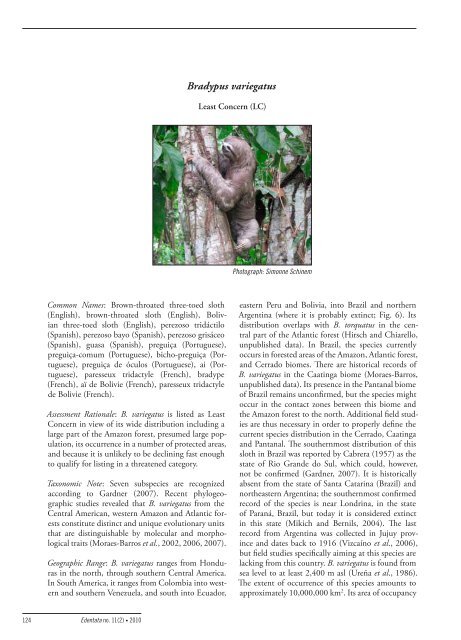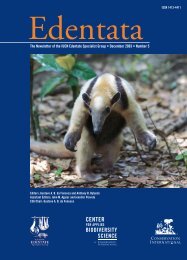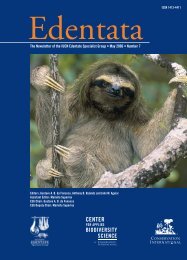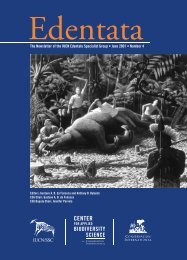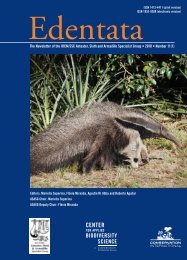Edentata 11(2), 2010 - Anteater, Sloth & Armadillo Specialist Group
Edentata 11(2), 2010 - Anteater, Sloth & Armadillo Specialist Group
Edentata 11(2), 2010 - Anteater, Sloth & Armadillo Specialist Group
- No tags were found...
You also want an ePaper? Increase the reach of your titles
YUMPU automatically turns print PDFs into web optimized ePapers that Google loves.
Bradypus variegatusLeast Concern (LC)Photograph: Simonne SchinemCommon Names: Brown-throated three-toed sloth(English), brown-throated sloth (English), Bolivianthree-toed sloth (English), perezoso tridáctilo(Spanish), perezoso bayo (Spanish), perezoso grisáceo(Spanish), guasa (Spanish), preguiça (Portuguese),preguiça-comum (Portuguese), bicho-preguiça (Portuguese),preguiça de óculos (Portuguese), ai (Portuguese),paresseux tridactyle (French), bradype(French), aï de Bolivie (French), paresseux tridactylede Bolivie (French).Assessment Rationale: B. variegatus is listed as LeastConcern in view of its wide distribution including alarge part of the Amazon forest, presumed large population,its occurrence in a number of protected areas,and because it is unlikely to be declining fast enoughto qualify for listing in a threatened category.Taxonomic Note: Seven subspecies are recognizedaccording to Gardner (2007). Recent phylogeographicstudies revealed that B. variegatus from theCentral American, western Amazon and Atlantic forestsconstitute distinct and unique evolutionary unitsthat are distinguishable by molecular and morphologicaltraits (Moraes-Barros et al., 2002, 2006, 2007).Geographic Range: B. variegatus ranges from Hondurasin the north, through southern Central America.In South America, it ranges from Colombia into westernand southern Venezuela, and south into Ecuador,eastern Peru and Bolivia, into Brazil and northernArgentina (where it is probably extinct; Fig. 6). Itsdistribution overlaps with B. torquatus in the centralpart of the Atlantic forest (Hirsch and Chiarello,unpublished data). In Brazil, the species currentlyoccurs in forested areas of the Amazon, Atlantic forest,and Cerrado biomes. There are historical records ofB. variegatus in the Caatinga biome (Moraes-Barros,unpublished data). Its presence in the Pantanal biomeof Brazil remains unconfirmed, but the species mightoccur in the contact zones between this biome andthe Amazon forest to the north. Additional field studiesare thus necessary in order to properly define thecurrent species distribution in the Cerrado, Caatingaand Pantanal. The southernmost distribution of thissloth in Brazil was reported by Cabrera (1957) as thestate of Rio Grande do Sul, which could, however,not be confirmed (Gardner, 2007). It is historicallyabsent from the state of Santa Catarina (Brazil) andnortheastern Argentina; the southernmost confirmedrecord of the species is near Londrina, in the stateof Paraná, Brazil, but today it is considered extinctin this state (Mikich and Bernils, 2004). The lastrecord from Argentina was collected in Jujuy provinceand dates back to 1916 (Vizcaíno et al., 2006),but field studies specifically aiming at this species arelacking from this country. B. variegatus is found fromsea level to at least 2,400 m asl (Ureña et al., 1986).The extent of occurrence of this species amounts toapproximately 10,000,000 km 2 . Its area of occupancy124<strong>Edentata</strong> no. <strong>11</strong>(2) • <strong>2010</strong>


